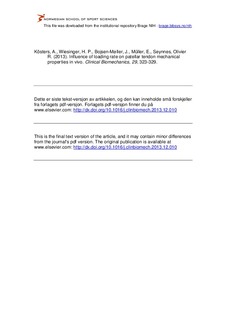| dc.contributor.author | Kösters, Alexander | |
| dc.contributor.author | Wiesinger, Hans-Peter | |
| dc.contributor.author | Bojsen-Møller, Jens | |
| dc.contributor.author | Müller, Erich | |
| dc.contributor.author | Seynnes, Olivier R. | |
| dc.date.accessioned | 2014-03-19T10:05:15Z | |
| dc.date.available | 2014-03-19T10:05:15Z | |
| dc.date.issued | 2014-03 | |
| dc.identifier.citation | Clinical Biomechanics. 2013, 29, 323-329 | nb_NO |
| dc.identifier.uri | http://hdl.handle.net/11250/192664 | |
| dc.description | I Brage finner du siste tekst-versjon av artikkelen, og den kan inneholde ubetydelige forskjeller fra forlagets pdf-versjon. Forlagets pdf-versjon finner du på http://dx.doi.org/10.1016/j.clinbiomech.2013.12.010 / In Brage you'll find the final text version of the article, and it may contain insignificant differences from the journal's pdf version. The definitive version is available at http://dx.doi.org/10.1016/j.clinbiomech.2013.12.010 | nb_NO |
| dc.description.abstract | Background: Rate-dependent properties of tendons have consistently been observed in vitro but in vivo studies comparing the effects of loading duration on this feature remain conflicting. The main purpose of the present study was to evaluate whether tendon loading rate per se would affect in vivo tendon mechanical properties.
Methods: Twenty-two physically active male subjects were recruited. Patellar tendon deformation was recorded with ultrasonography under voluntary isometric contractions at rates of 50, 80 and 110 Nm/s, controlled via visual feedback.
Findings: Subjects were able to accurately generate all three loading rates (Accuracy = 2% to 15%), with a greater steadiness at 50 (CV = 12.4%) and 110 Nm/s (CV = 13.1%) than at 80 Nm/s (CV = 22.9%). Loading rate did not appreciably affect strain or stress. However, stiffness (ɳp2 = 0.555) and Youngs's Modulus (ɳp2 = 0.670) were significantly higher at 80 Nm/s (21.4% and 21.6%, respectively) and at 110 Nm/s (32.5% and 32.0%, respectively) than at 50 Nm/s. Similarly, stiffness and Young's modulus were 9.9% and 8.8% higher, respectively, at 110 Nm/s than at 80 Nm/s.
Interpretation: These results indicate that in vivo measurements of patellar tendon mechanics are influenced by loading rate. Moreover, they bear important methodological implications for in vivo assessment of mechanical properties of this tendon and possibly other human tendons. | nb_NO |
| dc.language.iso | eng | nb_NO |
| dc.publisher | Elsevier | nb_NO |
| dc.subject | VDP::Matematikk og Naturvitenskap: 400::Basale biofag: 470 | nb_NO |
| dc.subject | VDP::Teknologi: 500::Medisinsk teknologi: 620 | nb_NO |
| dc.subject | VDP::Medisinske Fag: 700::Basale medisinske, odontologiske og veterinærmedisinske fag: 710 | nb_NO |
| dc.subject | VDP::Medisinske Fag: 700::Klinisk medisinske fag: 750 | nb_NO |
| dc.subject | ultrasonography | nb_NO |
| dc.subject | viscoelasticity | nb_NO |
| dc.subject | in vivo testing | nb_NO |
| dc.title | Influence of loading rate on patellar tendon mechanical properties in vivo | nb_NO |
| dc.type | Journal article | nb_NO |
| dc.type | Peer reviewed | nb_NO |
| dc.source.journal | Clinical Biomechanics | nb_NO |
| dc.identifier.doi | 10.1016/j.clinbiomech.2013.12.010 | |
| dc.description.localcode | Seksjon for fysisk prestasjonsevne / Department of Physical Performance | nb_NO |
